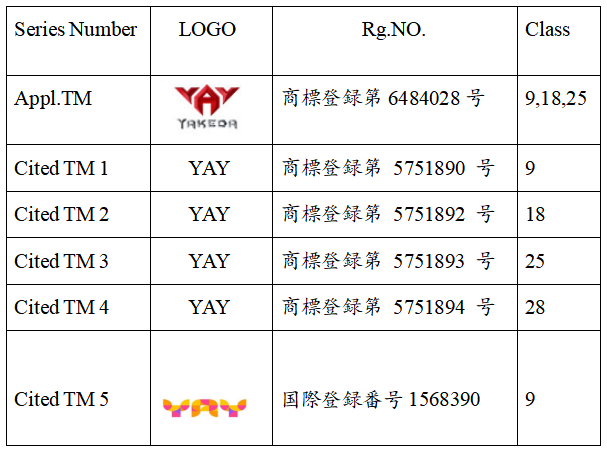CENFO represented "YAKEDA" trademark similarity review case successfully
2023-03-04
Case Brief
Judgement
The JPO considered that the disputed trademark was significantly different from the five prior trademarks cited in terms of word and shape, pronunciation of the trademark name, meaning of the trademark name and commercial impression, which were not likely to cause confusion among consumers in the market. The disputed trademark finally successfully passed the examination and was successfully registered in Japan.
Case Review
Our client (hereinafter referred to as "the applicant") filed a trademark application with the Japan Patent Office for the trademark "YAKEDA" in Class 9,18,25. However, the examiner of the Japan Patent Office found that the applicant's trademark and the five prior registered trademarks cited below constituted a high degree of similarity in terms of word and pronunciation, and that the similarity groups of the designated goods of the applicant's trademark and the similarity groups of the goods of the cited trademarks completely overlapped, so the trademark applied for by our client was rejected.
The trademark comparison information is as follows:

Typical significance
Our client has already used the trademark "YAKEDA" extensively in Japan before the filing date, and a complete and effective chain of evidence has been formed, which is sufficient to prove that the mark has been widely used in Japan for a long time and is well known to Japanese consumers. Therefore, whether the disputed trademark can be successfully registered in Japan will have a significant impact on our client.
After receiving our trust to review the case, our Japanese attorney focused on the following points to discuss the differences between the disputed trademark and the five prior trademarks cited through extensive comparison and investigation work.
The composition of word is obviously different. The upper part of the disputed trademark is actually the graphic design of "VAV", rather than the "YAY" of the cited trademark
2. The design of shape is different. The lower part of the graphic design of the disputed trademark"YAKEDA" and its unique design of color can be clearly distinguished from the cited trademark.
3. The pronunciation is completely different. The main identifying part of the disputed trademark is "YAKEDA", which contains three syllables, while the cited trademark mainly contains the word "YAY", pronounced as [jeɪ], which is much simpler.
4. The meaning and commercial impression of the trademark are different. The lower part of "YAKEDA" applied for by the applicant in the Japanese has no real meaning in the English dictionary, while "YAY" in the cited trademark can be understood as an English exclamation, which is similar to the meaning of "YEAH “. Therefore, it brings a different commercial impression.
5. The applicant's trademark has been used in Japan for a long time and widely advertised, and it is well known to Japanese consumers who have the ability to recognize it.So it will not cause confusion in the same market.
In addition, we assist our client to settle and submit a large amount of use evidence of the trademark to prove the use, sales, market share, advertising, scale and scope of the goods designated by the trademark in Japan. It is also sufficient to prove that the mark had a certain degree of popularity and reputation before the filing date.
In summary, the Japanese trademark applied for by the applicant was not similar to the five prior trademarks cited by the Japanese examiner, and the registration of the disputed trademark did not violate the provisions of the Japanese Trademark Law. In the end, the trademark "YAKEDA" passed the examination of the Japan Patent Office and successfully obtained the approval certificate.
Therefore, if a trademark is officially rejected on the way of overseas application, the trademark owner should actively entrust a professional intellectual property company to assist in defending the trademark rights and interests in order to "go abroad", especially for the brand name that has entered the market, if the trademark is invalid due to the abandonment of the defense, it will cause unforeseeable losses to the brand value and future development of the enterprise.
At the same time, we usually need to pay attention to the use evidence of the trademark in the process of retention, to ensure that it can form a complete chain of evidence, this is conducive to improving the success rate of the rejection of the trademark review.
Source: Website of CENFO